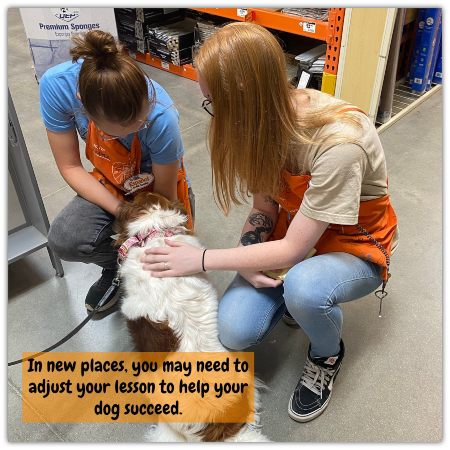A dog training lesson from the field: When you are training in new places (or with new or more distractions), you may need some adjustments to help you and your dog succeed.
 Case in point. Sassy has been doing so well with her loose leash walking, ‘drop’ (meaning lay down), and sit in her home and mildly distracting outdoor locations. However, we took her to Home Depot the other day for a new environment to practice. It happened to be an inventory day and there were a lot of people milling around. There was even a dog.
Case in point. Sassy has been doing so well with her loose leash walking, ‘drop’ (meaning lay down), and sit in her home and mildly distracting outdoor locations. However, we took her to Home Depot the other day for a new environment to practice. It happened to be an inventory day and there were a lot of people milling around. There was even a dog.
For a dog like Sassy whose body become all wiggly as she solicits attention and head rubs when meeting all kinds of people, that made for a very difficult learning environment. When we asked her to drop, she simply stood and looked at us (and looked around a little) and wagged her body.
In that moment, she was not a dog trying to be stubborn. She truly could not do the behavior in that difficult of an environment. Rather than continuing to ask her to ‘drop’ and continuing to fail, we moved a little bit out of the way and took the lesson back steps. I stopped using the cue temporarily and used my hand as a prompt for her to follow it to the ground, to get her into the position, then marked and treated her for being in that position. When she able to do this fluently, I re-inserted the cue just before she went into the laying down position. Very quickly she was able to do it again. Soon I was able to just tell her to ‘drop’ and she did. This video only shows a portion of us working on it.
It is a reminder that, when you change environments where you are training, the lesson becomes a whole lot more difficult for your learner. Think about yourself. You may be able to process a difficult lesson in a quiet area. However, if you are taken to a place with lots of activity and sounds going on around you, maybe even with people trying to come up to you to ask you questions, you are probably going to have a more difficult time thinking through that problem.
Help your learner out by making the lesson easier. That can mean going back to the beginning of teaching the behavior, moving farther away from the distraction, giving your learner breaks in the lesson, asking for easier behaviors first, or a combination of these things.







